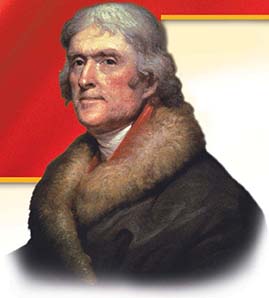SECTION 3: The Age of Jefferson


◄ President Thomas Jefferson, with a banner (right) from his 1800 presidential campaign
WITNESS HISTORY  AUDIO
AUDIO
Jefferson Calls for Free Speech
In 1801, Thomas Jefferson became the nation’s third President. He emphasized that the federal government should respect public opinion and should allow public criticism—implying that the previous Federalist administration had fallen short on those scores. In an eloquent Inaugural Address, Jefferson insisted that the Republic needed free speech and constant debate.
“If there be any among us who wish to dissolve the union, or to change its republican form, let them stand undisturbed as monuments of the safety with which error of opinion may be tolerated where reason is left free to combat it.”
—Thomas Jefferson, Inaugural Address, 1801
Objectives
- Understand why some saw Jefferson’s election as a “republican revolution.”
- Explain the impact of John Marshall’s tenure as Chief Justice of the United States.
- Identify the importance of the Louisiana Purchase.
- Analyze Jefferson’s foreign policies.
Terms and People
- bureaucracy
- John Marshall
- judicial review
- Marbury v. Madison
- Louisiana Purchase
- Lewis and Clark Expedition
- Barbary War
- impressment
- embargo
NoteTaking
Reading Skill: Identify Main Ideas Record main ideas about Jefferson’s presidency in a concept web like the one below.

Why It Matters In addition to capturing the presidency in 1800, the Democratic Republicans won control of Congress and most of the state governments. The Federalists would never reclaim national power. Besides taking government in a new direction, the Jefferson administration left a profound legacy with its acquisition of new territory. Section Focus Question: What were the successes and failures of the Jefferson administrations?
Pursuing Republican Principles
When the Democratic Republicans took power, they spoke of the election as a “revolution.” Jefferson insisted that “the Revolution of 1800 was as real a Revolution in the principles of our government as that of 1776 was in its form.” In that view, those in the Jefferson administration set out to do things quite differently from their predecessors, who had copied the style of the British monarchy.
New Government Policies
Jefferson encouraged Congress to abandon the Alien and Sedition Acts, as well as the hated taxes on stamps, land, and alcoholic spirits. Unlike Hamilton, Jefferson wanted to retire the national debt by paying it down. Despite reducing taxes, he cut the national debt from $80 million when he took office to $57 million in 1809. To do this he made major cuts to the army and navy and streamlined the government’s bureaucracy, or the departments and workers that make up the government. He also benefited when customs revenue from imports increased with a dramatic growth in foreign trade. In addition, the westward movement of American farm families increased the sale of federal lands. These two revenues drove down the federal debt.




